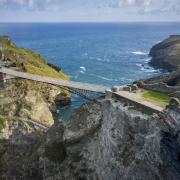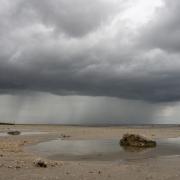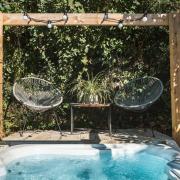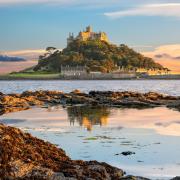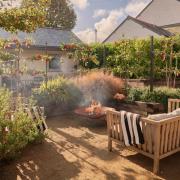Through hidden garden gates, perched perilously on cliffs and concealed on islands out at sea can be found the most incredible springtime gardens. Author Tim Hubbard explores 20 of these stunning spaces in his new book, Secret Gardens of Cornwall, and shares a few of them here with us
Even though visitors from all over the UK and Europe flock to Cornwall throughout the year to enjoy the county’s rich and varied horticultural history, it’s at this time of year that Cornish gardens come into their own. In his new book, Tim has chosen twenty, lesser-known gardens to explore. Some of them are physically ‘secret’ behind high walls or hedges, some are simply not well known and some - like the private family gardens on St Michael’s Mount - are just not as visited as the more famous attractions alongside.
Many of Tim’s choices reflect the fact that the season starts early here - camellias can flower before Christmas, magnolias in February and rhododendrons in March. For years the county had a thriving cut flower trade, with early flowering narcissi and violets being sent daily by train to the London markets. ‘Cornish earlies’ are the first potatoes to be harvested on the mainland and by May and June each year most of the gardens are at their peak.
Temperatures are mild. The land is surrounded by the sea on three sides and so is bathed by the warming Gulf Stream. The sea also moderates the temperatures inland, so it is relatively warmer in winter and cooler in summer. Light levels are strong and coastal locations benefit from the intense light reflected from the sea. A third factor is that rainfall totals are high - a rough average is about 1,000 millimeters (just over three feet) of rainfall each year - although some places are much wetter.
Each year there is a race to declare that spring has sprung in Cornwall. The Great Gardens of Cornwall organise a challenge in which gardeners who oversee champion magnolia trees at six gardens – Trebah, Trewidden, Caerhays, Heligan, Tregothnan and Trewithen – all keep a close eye on the number of their magnolia blooms as they begin to emerge. When each of the six gardens can report fifty blooms, they declare that spring has well and truly arrived. Visitors can then enjoy the spectacular flowers which mark the start of a general flowering season which peaks about now and goes on throughout the summer and early autumn.

One of the Secret Gardens chosen for the book is alongside the world famous Minack Theatre in West Cornwall. It’s a great example of a seaside garden superbly placed to take advantage of the effects of the mild conditions. Additionally, the granite rocks on which the garden is based, and which surround many of the plants, act as giant storage heaters; absorbing the sun’s warmth and then gradually releasing it into the ground, enabling southern hemisphere plants such as aloes, aeoniums and agapanthus to thrive. Cared for by award-winning Joint Head Gardeners Jeff Rowe and Claire Batten the garden is now a triumph - both of what can be grown on the Cornish mainland and also of design. Claire makes the point that visitors can look straight down the cliff onto the planting as well as into the beds from the side.

‘We have to be careful when we design here,’ she says. ‘When you’re looking down the cliff from our viewing platform or the upper terraces the vertical view is really important.’
Elsewhere in the Minack garden there are clear signs of Jeff’s passion for the protea family, which includes banksia, grevillea and leucadendron. ‘I love the form and colour of them, as well as the texture of the flowers which is just amazing,’ he enthuses. ‘We’re including as many as we can here - even on the drive as a taster of what’s ahead’.

One other Secret Garden of Cornwall that comes into its own at this time of year is Bonython Estate Gardens near Cury Cross Lanes on The Lizard. The owner of the property in the 1920’s, Mary Lucy Lyle, firmly declared: ‘no flowers or colour in the garden’. Nowadays nothing could be further from the truth as owners Richard and Sue Nathan, who bought the property in 1999, have created a romantic garden with various carefully chosen colour palettes and exquisite flower planting.
Sue comes from South Africa and is an artist; her love of colour is everywhere. There are three lakes within the garden and alongside one is a spectacular hot border filled with cannas, restios and ornamental grasses providing vibrant splashes of reds, oranges, and yellows that seem to shimmer and blaze in the sun. ‘I love this planting,’ declares Sue. ‘With the azaleas and ligularias the colour spectrum is intense - just like those sunsets I knew in South Africa’. Beyond the lakes, springtime walks through the garden’s woodland areas lead visitors through banks of colourful rhododendrons, azaleas and spectacular flowering shrubs interspersed with native trees and Dicksonia antarctica.


One of the most spectacular design elements of Bonython Estate Gardens is the contemporary planting of some 150 silver birch trees. Sue cleared an area of scrub and woodland to build a perfectly circular, lawned mound. On the top, like a cherry on a cupcake, is a striking abstract metal sculpture suggesting the form of a springtime bud. Surrounding the mound are the precisely spaced birches, planted regularly to create a circular grove. Alongside is an area of choice acers, including Acer ‘Silver Cardinal’ - a birthday present for Sue from husband Richard at the Chelsea Flower Show. ‘It looks stunning here,’ shares Sue. ‘This is the snake-bark maple; as well as the extraordinary texture of the branches, it has red young shoots and lime green bracts which look amazing against a blue sky.’
Another of Tim’s choices is Patrick Gale and Aidan Hicks’ Trevilley near Land’s End. On the site of a former concrete farmyard the couple have created the most westerly rose garden in Great Britain. It’s one of the windiest sites in the country and a shelter belt - as in many other gardens - was an important first step. Formally planned on paper, raised beds are surrounded by carefully cobbled pathways. Aidan carefully chose varieties of roses in shades of red and pink to flower throughout the spring and early summer. Varieties which made the grade include Rosa x Odorata ‘Mutabilis’, R. ‘Jacqueline du Pre’, R. ‘Pink Flower Carpet’ and R. ‘De Resht’.

Other parts of the garden - an old green lane, a vegetable garden and a hot area of specialist planting around a striking outdoor fireplace are all tributes to their boundless enthusiasm and creativity including a tip that everyone can use to draw attention to special plants. This is an area of the garden filled with pots. ‘Whatever’s in flower gets centre stage,’ says Patrick. ‘It’s like changing the scenery.’
Find all the entrance details for these gardens and many more in Tim’s book, Secret Gardens of Cornwall, £22, Quarto/Frances Lincoln









